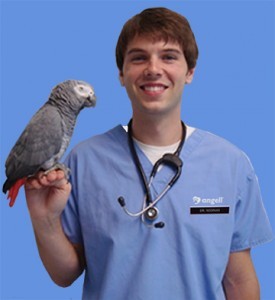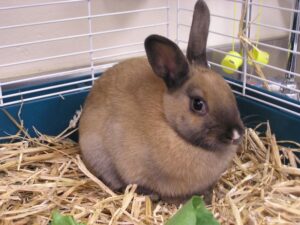-
Adopt
-
Veterinary Care
Services
Client Information
- What to Expect – Angell Boston
- Client Rights and Responsibilities
- Payments / Financial Assistance
- Pharmacy
- Client Policies
- Our Doctors
- Grief Support / Counseling
- Directions and Parking
- Helpful “How-to” Pet Care
Online Payments
Referrals
- Referral Forms/Contact
- Direct Connect
- Referring Veterinarian Portal
- Clinical Articles
- Partners in Care Newsletter
CE, Internships & Alumni Info
CE Seminar Schedule
Emergency: Boston
Emergency: Waltham
Poison Control Hotline
-
Programs & Resources
- Careers
-
Donate Now
 by Brendan Noonan, DVM, DABVP (Avian practice)
by Brendan Noonan, DVM, DABVP (Avian practice)
angell.org/avianandexotic
avianexotic@angell.org
617 989-1561
Diarrhea is a common presenting complaint from concerned owners of pet rabbits; however, rabbits rarely have true diarrhea, or in other words, liquid feces. Rabbits present more frequently with a waxing and waning history of soft, sticky stool that becomes adhered to their urogenital mound and tail. These rabbits require frequent cleaning and often have a pungent odor. Affected rabbits are usually producing normal stool in addition to the soft stool that ends up caked to their underside. These clinical signs are generally caused by production of loose cecotropes secondary to cecal dysbiosis. Recall that rabbits normally produce two types of stool, and cecotropes are the small amount of soft pellets defecated first that stick together like a cluster of grapes. The second type of stool is the fecal pellet, which is what owners are more used to seeing – the firm dry balls that end up in the litter box or scattered around the cage.
 The cecum is a highly developed, blind-ended pouch extending from the junction of the small and large intestine. Communities of bacteria and yeast thrive in the cecum and break down the otherwise indigestible fiber found in grasses and hay, providing essential nutrients and fatty acids. These fermentation products are then coated in mucous before they are excreted as cecotropes. Most rabbits will eat their cecotropes directly from their anus in the early morning, and their owners are thus unaware of any cecptrope production. The cecotropes are not chewed, leaving the mucous coating intact to protect the nutrient dense package from the low pH of the stomach until it can be reabsorbed in the small intestine1. Cecotropes provide essential short chain fatty acids, microbial proteins, B vitamins, and up to 30% of a rabbit’s nitrogen intake1.
The cecum is a highly developed, blind-ended pouch extending from the junction of the small and large intestine. Communities of bacteria and yeast thrive in the cecum and break down the otherwise indigestible fiber found in grasses and hay, providing essential nutrients and fatty acids. These fermentation products are then coated in mucous before they are excreted as cecotropes. Most rabbits will eat their cecotropes directly from their anus in the early morning, and their owners are thus unaware of any cecptrope production. The cecotropes are not chewed, leaving the mucous coating intact to protect the nutrient dense package from the low pH of the stomach until it can be reabsorbed in the small intestine1. Cecotropes provide essential short chain fatty acids, microbial proteins, B vitamins, and up to 30% of a rabbit’s nitrogen intake1.
Cecal dysbiosis refers to the disruption of the delicate balance of organisms within the rabbit’s digestive tract. The cecum acts as a large fermentation vat comprised of many types of anaerobic organisms, such as Bacteroides species, gram negative oval and fusiform rods, amoeba, and protozoa.2 The cecum also carries a species of Sarcomyces yeast (Cyniclomyces guttulatus) in low numbers under normal circumstances. One of the most common ways owners unknowingly contribute to cecal dysbiosis is by feeding rabbits food items that are too high in simple sugars and starches. These diets typically also have reduced fiber content, which results in cecocolic hypomotility. When the normal flora population is exposed to carbohydrates for long periods of time, excessive fermentation occurs and the populations of organisms shift. Yeast proliferate, and the typically low numbers of Escherichia coli and Clostridium species begin to multiply, resulting in soft stool or in severe cases, true diarrhea. The excess glucose allows Clostridium to create iota-toxin, which can result in enterotoxemia and death.2
When house rabbits are not forming normal cecotropes, they are missing out on an essential part of their nutrition, and are at high risk for a life-threatening shift in their cecal flora. A thorough review of the provided diet is essential to get these rabbits back on track. Some of the most common causes are offering too many sweet treats, such as fruit, crackers, bread, cereal, commercial treats, and pellets with extra ingredients mixed in. Even carrots can be too high in starches for some rabbits. All of these items should be removed from the diet immediately, and the focus should shift to increasing the amount of fiber. This is most effectively done by increasing the grass hay component of the diet (e.g. timothy hay, orchard grass, oat hay). Alfalfa is a legume hay that tends to have more carbohydrates and protein and should be avoided. Leafy greens (e.g. romaine, endive, dandelion greens, etc.) can be offered at 2 cups per five pounds of rabbit per day. Hay and greens alone can provide all of the essential components of a healthy rabbit diet. Pellets can eventually be reintroduced (1/8 cup per 5lbs of rabbit) once the soft cecotropes have subsided. Depending on the severity of the shift in cecal flora, it may take days to weeks before the cecotropes achieve normal consistency. If the affected rabbit does not eat hay on a regular basis, then providing a high fiber timothy pellet should be substituted for any commercial pellet/seed/dried fruit treat mixes while hay is introduced.
For more information about Cecal Dysbiosis in rabbits or about Angell’s Avian and Exotic service, please call 617 989-1561 or e-mail avianexotic@angell.org.
REFERENCES
- Vella D, Donnelly TM. Basic Anatomy, Physiology and Husbandry. In Quesenberry K, Carpenter J (eds): Ferrets, Rabbits, and Rodents: Clinical Medicine and Surgery, 3rd ed. St. Louis: Elsevier, 2012, P 161-163.
- Oglesbee BL, Jenkins JR. Gastrointestinal Diseases. In Quesenberry K, Carpenter J (eds): Ferrets, Rabbits, and Rodents: Clinical Medicine and Surgery, 3rd ed. St. Louis: Elsevier, 2012, P 193-195.